ActiveHiking & WalkingWhat’s a shank? We explain the anatomy of a hiking bootWe sneak a peak under the hood of the humble hiking boot to find out how it worksWhen you purchase through links on our site, we may earn an affiliate commission.Here’s how it works.
ActiveHiking & WalkingWhat’s a shank? We explain the anatomy of a hiking bootWe sneak a peak under the hood of the humble hiking boot to find out how it worksWhen you purchase through links on our site, we may earn an affiliate commission.Here’s how it works.
We sneak a peak under the hood of the humble hiking boot to find out how it works
When you purchase through links on our site, we may earn an affiliate commission.Here’s how it works.
(Image credit: Palladium/Finisterre)
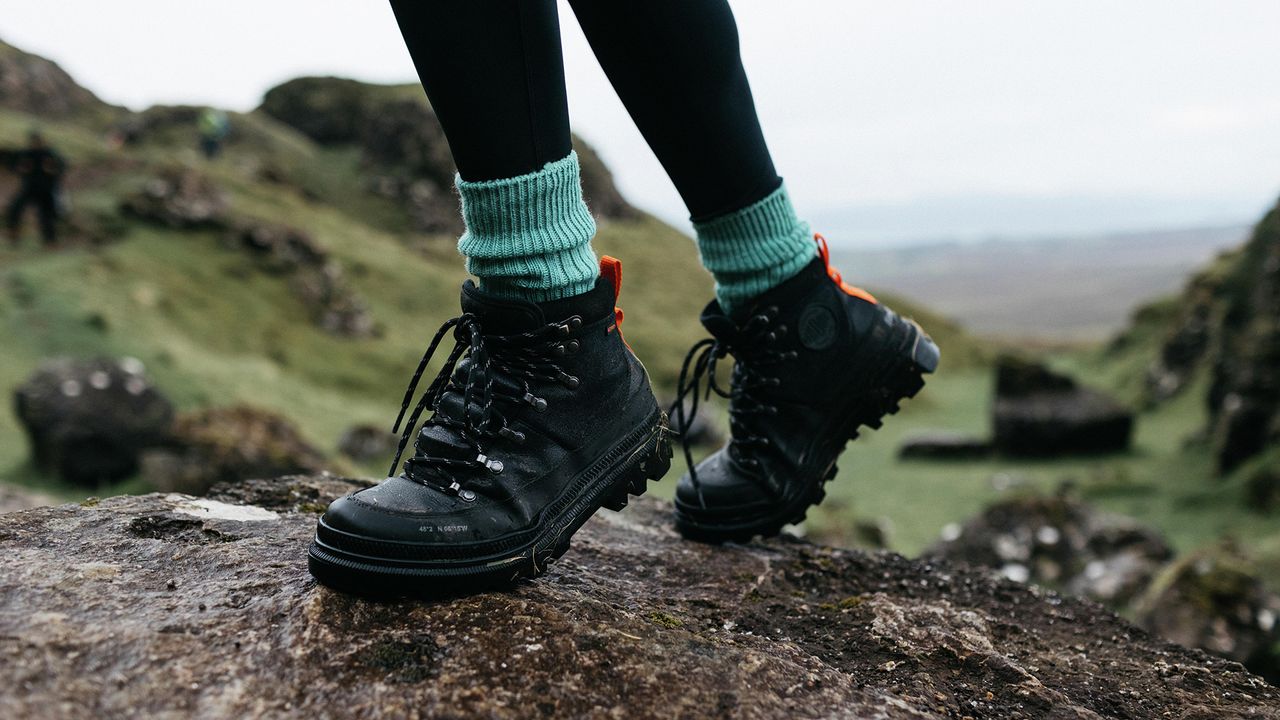
(Image credit: Palladium/Finisterre)
Jump to category:ChassisCollarPull loop/Pull tabMembraneLining and insulationTongueLacesHeel cupToe boxInsoleMidsoleShankRandToecapOutsoleLugs
Jump to category:ChassisCollarPull loop/Pull tabMembraneLining and insulationTongueLacesHeel cupToe boxInsoleMidsoleShankRandToecapOutsoleLugs
Long gone (thankfully) are the days when all hiking boots were fashioned from thick leather and heavy rubber, and you had to break them in for months before they were supple enough to wear out on the hills and trails without crippling you with blisters.
These days, thebest hiking boots for menandbest women’s hiking bootsare made with a smart mixture of materials, often (but not always) still including leather and suede but also employing high-performing, lightweight and long-lasting synthetic fabrics that make the footwear soft and comfortable straight out of the box.
But there is more – much, much more – to a really good hiking boot than this simplistic description suggests, so here we’re going to break it down properly.
Hiking boot anatomy
Chassis
(Image credit: Getty Images)
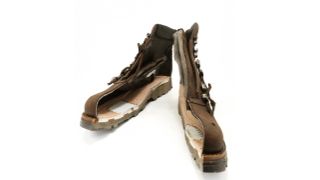
(Image credit: Getty Images)
Otherwise known as ‘the upper’, this refers to the entire top section of the boot, the main part of which is built around a ‘last’ (basically one of those wooden foot-shaped things you see in old cobbler’s shops, but slightly more modernised).
The chassis has various components that we will detail below, but its main job is to hold the foot securely and comfortably, minimizing internal movement, reducing the risk of twists, falls and other injury-creating incidents, and providing protection from the elements and the outside world in general.
Sign up to the T3 newsletter for smarter living straight to your inbox
Get all the latest news, reviews, deals and buying guides on gorgeous tech, home and active products from the T3 experts
Collar
(Image credit: Scarpa)
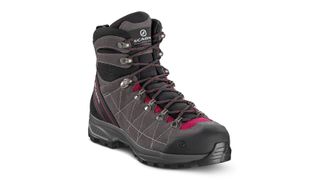
(Image credit: Scarpa)
The very top part of the boot, the collar might stop at the ankle (on a low-cut boot), just above the ankle joint (on a ‘mid’ height boot), or several centimetres above the ankle (on a high boot).
Higher collars are typically seen on more technically advanced boots designed for alpine use and/or wearing during the depths of winter, such as theScarpa R-Evo GTX.
The primary role of the collar is to supply support and confidence, especially around the ankle area when tackling tricky terrain, and particularly if you are carrying any real weight in ahiking backpack.
Pull loop/Pull tab
(Image credit: Pat Kinsella)
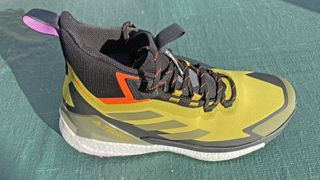
(Image credit: Pat Kinsella)
Found on the back of the collar, above the heel, a pull loop is simply there to help you get your feet into your boots nice and easily.
Membrane
Whatever it’s made of, the entire upper of a good hiking boot will be lined with a waterproof, breathable membrane, such asGore-Tex, to keep yourbest walking socksdry, while still letting your feet breathe.
Reliable waterproofing is a crucial feature for hiking boots and shoes (unlike trail running shoes) because you’re more likely to be wearing them for a lot longer each day, and hikers move slower and are, therefore, more susceptible to getting cold.
Lining and insulation
(Image credit: Sian Lewis)

(Image credit: Sian Lewis)
Most hiking boots will use a soft-feel breathable inner material to supply comfort to your feet while not impacting on the performance of the membrane and other technical fabric employed in the boot. Boots designed specifically for winter should have extra insulation, like theKeen Revel IV Polar High.
Tongue
Most modern hiking boots now have a gusted tongue that’s integrated into the main chassis, so there is no gap for grit or other debris to get through. This also maintains the waterproof integrity of the boot (there wouldn’t be much point in making the boot waterproof above the heel if water seeped in through the tongue as soon as you trod in an ankle-deep puddle or stream). Some – like theArc’teryx Norvan Nivalis GTX– even employ an in-built gaiter to improve this protection from the elements.
Laces
(Image credit: Fiona Russell)
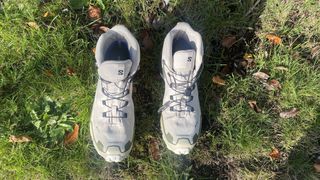
(Image credit: Fiona Russell)
The majority of hiking boots still feature fairly traditional laces, usually threaded through a mixture of eyelets or D-rings (at the bottom of the tongue) and speed hooks at the top, closer to the collar, which helps you get a good tight fit, but still get the boot on and off quickly.
Some brands, however, especially those that focus on really lightweight footwear forfastpackingand speed hiking – have experimented with quick lace, cables and boa-style systems, as seen on theSalomon Cross Hike 2.
Heel cup
(Image credit: Mark Mayne)
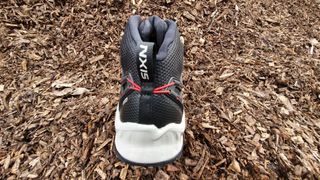
(Image credit: Mark Mayne)
A crucial component of a hiking boot upper is the heel cup. To avoid problems such as blisters and blackened toenails, you need your boots to fit perfectly, achieving a secure hold that prevents your feet from sliding around inside the chassis. After selecting the right size, much of this comes down to a good heel cup and locking system, such as the design onKeen’s NXIS Evo boots.
Toe box
(Image credit: Mark Mayne)
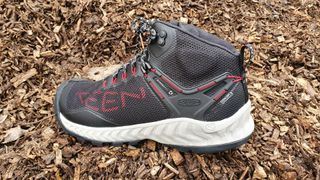
(Image credit: Mark Mayne)
This is the area at the front of the boot where your toes live. Of course, it is. One of the main considerations to factor in when choosing the best hiking boots for you is comfort and a lot of that boils down to whether your toes have room to spread (good) or if they feel cramped (bad). If you have broad feet or bunions, then look for a brand that offers boots with a wide fit as well as a regular fit, like theLowa Renegade.
Insole
(Image credit: Pat Kinsella)
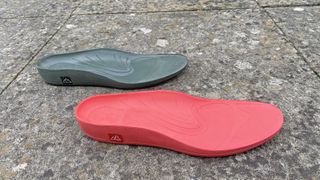
(Image credit: Pat Kinsella)
TheHaglofs Duality AT2 bootseven come with interchangeable inserts (pictured above) that sit somewhere between an insole and midsole and can be swapped according to whether you’re hiking in the hills and mountains or taking on flat terrain.
Midsole
(Image credit: Pat Kinsella)
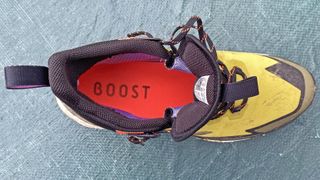
(Image credit: Pat Kinsella)
Suspension for your legs, the midsole on a good hiking boot absorbs and dampens some of the impact that happens when you repeatedly put one foot after the other for many hours and multiple miles, easing the stress placed on your knees, ankles and feet.
Typically constructed with ethylene-vinyl acetate (EVA) foam or polyurethane (PU), the best midsoles allow some trail feedback while still providing some cushioning for your feet, and even supplying a bit of bounce to help propel you forwards, as seen in the excellentAdidas Terrex Free Hikers.
There are barefoot hiking boots out there, like theVivobarefoot Tracker Decon FG 2, which have little to no midsole at all, but models from other brands, such as theHoka One One Anacapa Low GTX, use large, chunky midsoles, dispensing with all ground feel in the process. Most hiking boots strike a happy medium, as seen in models like theJack Wolfskin Force Striker Texapore.
Shank
(Image credit: Arc’Teryx)
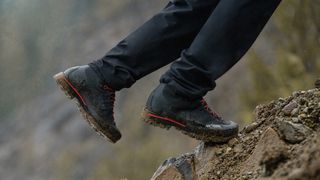
(Image credit: Arc’Teryx)
Typically made from either nylon or metal (thin steel), the shank is a semi-rigid insert that extends along the length of the boot beside (or within) the midsole.
More technical mountaineering boots need to be quite rigid to support your foot when edging around rocks and using crampons, as seen in the aceArc’teryx Acrux LT GTX.
Rand
This is a strip of protective reinforcement that runs around the lower edge of the boot chassis, just above the sole. Usually made from rubber, it works a bit like a bumper and can save you from injury from sharp sticks and stones while also shielding the less robust materials used in the chassis.
Toecap
(Image credit: Matthew Jones)
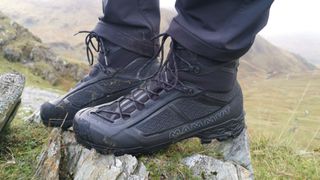
(Image credit: Matthew Jones)
Outsole
(Image credit: Pat Kinsella)

(Image credit: Pat Kinsella)
A crucial consideration when choosing any form of outdoor footwear – from decentwelliesto functional work boots, but especially when considering hiking hooves – is the part of the boot that provides the all-important features of grip, traction and braking control.
Made from a rubber compound, hiking boot outsoles feature lugs and/or chevrons that work like studs to grip the surface of whatever terrain you are traversing to prevent you from sliding over.
These lugs vary in depth (usually between 3mm and 5mm), and they’re arranged in various patterns to provide traction when you’re moving forward and upwards and braking control when you are descending on slippery, muddy or icy terrain.
Beware: Lug patterns that are too closely clustered can collect heavy mud, which will massively increase the weight of your boots; conversely, wide-spaced aggressive (deep) lug patterns can be uncomfortable to walk on when the surface is hard-packed or sealed.
Lugs
(Image credit: Pat Kinsella)
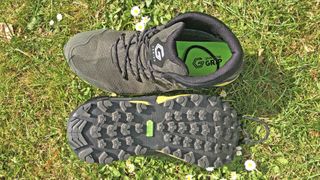
(Image credit: Pat Kinsella)
There are so many variations and things to weigh up here that lugs demand their own heading. The deeper the lug, the more aggressive and grippy the sole is on softer surfaces such as mud and snow, but consider how much you need this level of grip because chunky outsoles are also heavy.
The softer the rubber used in the lugs, the more grippy the boot will be on rocky surfaces, but the quicker those lugs will wear out. Harder compounds can last for decades but can be treacherously skiddy on smooth, wet rocky surfaces.
In recent years, British brand inov-8 has pioneered the use of graphene (a crystalline carbon highly regarded for its incredible toughness and longevity) in the outsoles of their hiking footwear, such as the excellentRoclite Pro G 400 GTX bootsand theRocfly G390(which even features graphene in the midsole).

Amy Schumer’s Netflix comedy will leave your jaw on the floorOne big taboo gets busted in Kinda Pregnant
One big taboo gets busted in Kinda Pregnant

10 minutes, two dumbbells and this standing workout for more sculpted armsTone your arm the fun way with this no-repeat workout
Tone your arm the fun way with this no-repeat workout

Change my mind: the smaller, the better with portable power stationsPut your portable power station to work when you’re not using it
Put your portable power station to work when you’re not using it

This rugged adventure Garmin is mega cheap in Walmart’s Black Friday saleThe Instinct 2 is a top watch for outdoor and sport enthusiasts
The Instinct 2 is a top watch for outdoor and sport enthusiasts

YETI’s best-selling products are ridiculously cheap in Amazon’s Black Friday saleFancy yourself a tumbler, rambler or cooler? Amazon’s reduced them all
Fancy yourself a tumbler, rambler or cooler? Amazon’s reduced them all

Knee pain when hiking? Try these four helpful hacks from a strength coachThere’s no need to hang up your hiking boots just yet
There’s no need to hang up your hiking boots just yet

Feeling cold on your winter hike? An outdoor expert says you’re making this mistakeApparently it’s common with ‘first-time hikers’
Apparently it’s common with ‘first-time hikers’

5 gadgets you need for your fastpacking adventure, according to an outdoor expertIf you aren’t taking these out for a fastpack, then it’s time too!
If you aren’t taking these out for a fastpack, then it’s time too!

What’s fastpacking: the adventure sport that lets you go further, faster, and lighter on the trailsTrail running meets backpacking for one epic adventure
Trail running meets backpacking for one epic adventure

Columbia Wyldwood Waterproof Hiking Shell review: the most waterproof (and shiny) jacket I’ve ever wornIt might not have the matt finish most people expect from a jacket, but the Wyldwood really shines when it comes to protecting you from wet and windy weather
It might not have the matt finish most people expect from a jacket, but the Wyldwood really shines when it comes to protecting you from wet and windy weather